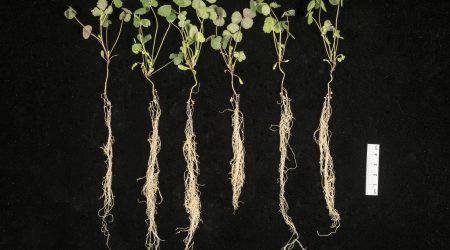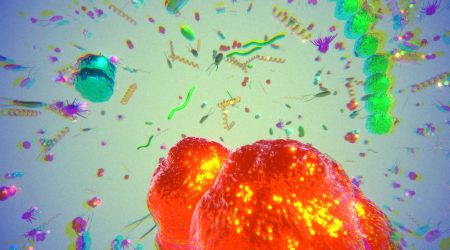A round-up of recent research from the John Innes Centre from winter 2021
Stress test finds cracks in the resistanceof harmful hospital bugs
Critical factors that enable dangerous bacteria to survive on surfaces have been identified and could lead to new ways of killing them.
“We have shown how a dangerous human pathogen Pseudomonas aeruginosa responds to environmental challenges, such as salt stress or drying out. Disrupting the production of certain stress-tolerance sugars in this bug significantly reduces its ability to survive on kitchen and hospital worksurfaces,” says Dr Jacob Malone.
The team analysis of how a type of sugar molecule, trehalose, is metabolised by P. aeruginosa has uncovered its role in protection against external stresses. The next step for the research is to understand how trehalose and glycogen metabolic pathways are regulated in P. aeruginosa and closely related species.
- Read ‘Stress test finds cracks in the resistance of harmful hospital bugs’
Long search finds grain of hope in the glume
Identifying a genetic element that controls the elongated grains and glumes of Polish wheat, Triticum polonicum, could translate into genetic improvements and productivity.
It was known the features were controlled by one gene, and the team identified the molecular component as VRT-A2, part of the MADS-box family of transcription factors that act as genetic switches controlling protein synthesis.
Dr Nikolai Adamski says: “The results highlight how changes in expression of transcription factors can impact on important agronomic traits for crops such as wheat. We aim to use this knowledge to improve wheat productivity.”
How plants become good neighbours in times of stress
Shade is detected by phytochrome photoreceptors, and causes plants to grow long and tall to outgrow the competition. In the deep gloom of a dense forest or a cramped crop canopy, this strategy doesn’t work. It has been discovered that plants that are adapted to grow in deep shade conditions can modify their internal clocks.
The collaborative research from John Innes Centre and the University of Bristol identifies a previously unknown role for the circadian clock in regulating plant development. The findings have implications for both natural plant populations and crops.
How information beyond the genetic sequence is encoded in the plant sperm
A newly discovered molecular mechanism of DNA methylation reprogramming reveals how extra information is passed from parent to offspring in the genetic code. This stops the mobile genetic elements, transposons, jumping around in the germ cells and protects the integrity of the genome between generations.
DNA can be modified epigenetically via chemically induced modifications around the DNA, and the newly discovered mechanism adjusts these modifications, altering the way information beyond the genetic code is passed down the generations. It explains how some methyl markers are reset, affecting the information passed on to the next generation.
“This discovery changes the way we think about epigenetic inheritance across generations in plants by showing that small RNAs produced by germline nurse cells can determine the DNA methylome in the sperm. The key role played by these small RNAs in determining the inherited DNA methylome indicates convergent functional evolution between plant and animal reproduction,” says Dr Xiaoqi Feng.
The microbial molecule that turns plants into zombies
A newly discovered manipulation mechanism used by parasitic bacteria to slow down plant ageing may offer new ways to protect disease-threatened food crops. The new findings show how the bacterial protein known as SAP05 manipulates plants by taking advantage of some of the host’s own molecular machinery. When inside a plant, this protein causes key growth regulators to be broken down, triggering abnormal growth.
Professor Saskia Hogenhout says: “Phytoplasmas are a spectacular example of how the reach of genes can extend beyond the organisms to impact surrounding environments.
Our findings cast new light on a molecular mechanism behind this extended phenotype in a way that could help solve a major problem for food production.”
Unravelling fungal spore release mechanics to guide policy on barberry planting
Researchers have shown how fungal spores are released and dispersed, a step towards protecting cereal crops from one of their oldest enemies, stem rust.
The team from the Saunders group and the University of East Anglia studied how the tightly packed spores swell in dew or rainfall, exerting force on neighbouring spores. This leads to a catapult-style expulsion of spores in clusters, increasing ejection speeds. Dr Diane Saunders, co-corresponding author, says: “This is timely given that sporadic infections of wheat stem rust have been increasing in western Europe and the hedgerow species barberry is also increasing. Knowing how far these spores can travel will guide policy regarding safe distances for barberry plantings from cereal crops, while also identifying bushes at risk as sources of future stem rust infection.”
Gene-editing discovery yields high promise for wheat fertility in a changing climate
A gene with profound effects on the production of seeds has been identified. ZIP4 is responsible for maintaining 50 per cent of yield in wheat. Professor Graham Moore’s group used recent developments in wheat research technology to explain the genetic element that has puzzled scientists for more than 60 years: “We can now aim to identify variants of the gene that give resilience to climate change.”










